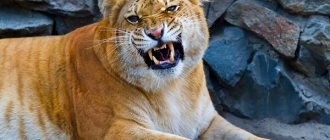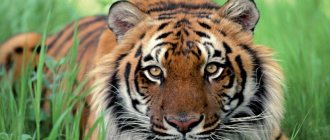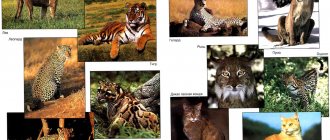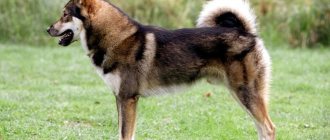This article describes animals such as the liger and the tiger lion. You will learn what their distinctive features and similarities are.
Few people know that in the world there are not only tigers and lions, but also their hybrids - ligers and tigrolves.
- It is impossible to find such animals among the natural flora and fauna, since lions live in Africa, and tigers are Far Eastern animals and inhabitants of India.
- But in wildlife parks, due to the fact that there is always not enough space for animals, baby tigers and lions are placed in common cages.
- These “kittens” grow, develop, and when they grow up, they have offspring.
- Cubs are born to 1-2 out of 100 mixed couples. Babies usually look like their fathers.
- Read the article to find out how the hybrids of these big “cats” are correctly called.
A little history of hybrid Panthers
Panther hybrids are obtained only in captivity by crossing in various combinations any cats of four species - Tigers, Lions, Leopards, Jaguars.
Ligers
Most hybrids are unable to survive in the wild because their males are usually sterile. Mitochondrial genome research has shown that wild hybrids were also present in ancient times. The mitochondrial genomes of the snow leopard and lion were more similar to each other than those of other Panther species, indicating that at some point in their history, the female offspring of the male ancestors of modern leopards and the female ancestors of modern lions interbred with the male ancestors of modern snow leopards .
In theory, Lions and Tigers can interbreed in the wild and produce offspring, but in reality there cannot be naturally born hybrids in the world because they are separated by behavioral and geographic differences.
However, in England, African Lions and Asian Tigresses were successfully mated, and in 1824 three hybrid cubs were born in Windsor, which were even presented to His Majesty the King. What is probably the earliest record of hybrid felinology of wild cats.
Liger
Liger
Tiger Lion Lifestyle
Tigons are much less common than ligers. This is due to the behavior of predators during the mating season. Lions are very active and are ready to mate at any time. Tigers, on the contrary, do not understand the signals given by the female lioness.
If offspring do appear, they rarely survive. Pathologies in the development of the cubs are possible, including birth before the due date. Raising such a baby, even if he was healthy, is not easy - the female does not have enough milk, and zoo staff have to feed the baby with formula from a bottle.
The birth of an unusual animal attracts a lot of people to the zoo or circus where this event took place. Breeding interspecific hybrids serves more to increase profits than to benefit the animals. Tigers living in zoos have not been observed to be aggressive towards humans. They, like their parents, feed mainly on raw meat; during the day they prefer to sleep in a shelter, getting out of it during feeding hours, in the morning or in the evening.
Mr. Cat recommends: a list of Panther hybrids
Below are two tables showing the many possible variations of Panthera hybrids. They, as a rule, are named by the “portmanteau” method, that is, a combination, a linguistic combination of the names of the parents. The name is obtained depending on which species is the father (this syllable will be the first) and which is the mother. For example, the cub of a Lion and a Tigress is called a Liger, because the Lion is a male parent, and the Tigress is a female.
First generation hybrid table
| Species from the genus Panthera | Tigress | Lioness | Jaguares | Leopardess |
| Tiger | Tigers Tigress | Tigon Tigonessa | Tiguar Tiguaressa | Tigard Tigardess |
| a lion | Ligress' liger | Leo Lioness | Liguar Liguaressa | Lipard Lipardessa |
| Jaguar | Jagger Jagressa | Jaglion Jaglionia | Jaguar Jaguares | JaguarpardJaguapardess _ |
| Leopard | Leoger Leogressa | Leopon Leoponessa | Leguar Leguaressa | Leopard Leopardess |
Leopons Tiguar
Female hybrids are fertile in the first generation. When crossed with males of different Panther species, they produce crosses of the second, third and subsequent generations.
Table of hybrids of the second, third and fourth generations
| Species from the genus Panthera | Tigonessa | Ligressa | Jaguarpardess | Leguaressa | Liguaressa |
| Tiger | Titigon Tigonessa | Tiliger Tiligress | Tijagupard Tijugapardessa | Tileguar Tileguaressa | Tiliguar Tiliguaressa |
| a lion | Litigon Litigonessa | Lilygress's Lilyger | Lidjugupard Lidjupardessa | Lileguar Lilleguaressa | Liliguard Liliguardessa |
| Jaguar | Yagtigon Yagtigonessa | Yagliger Yagligressa | Yaguagupardus Yaguagupardessa | Jagleguar Jagleguaressa | Yagliguar Yagliguaressa |
| Leopard | Leotigon Leotigonessa | Leoligress Leoligress | Leojaguapard Leojagupardessa | Leoleguar Leoleguaressa | Leoliguar Leoliguaressa |
| Leopon | Leoptigon | Leopliger | Leopard | Leopleguar | Leopliguar |
| Liger | Liton | Liger | Yagliger | Lilleguar | Liliguar |
| Jagger | Jagitonger | Jagiligr | Japanpadder | Jaleguar | Jaliguar |
Titigon
Litigon
What natural area does the animal live in?
The first hybrid of a tiger and a lioness was born in one of the zoos several centuries ago. Typically, tigons were born if tiger cubs and lion cubs were kept together, and when they matured, they could form pairs. Adult animals are wary of each other, and the chances of producing offspring from the union of different species are very small.
In nature, the modern habitats of tigers and lions do not overlap; they cannot meet to create a common pair and give birth to offspring. During the Pleistocene era, which ended about 11 thousand years ago, Europe and Siberia were inhabited by a predator, now extinct, called the tiger lion. He was the largest feline of all time. Scientists debated for a long time which species to classify this animal as - lions or tigers, and through genetic analysis they came to the conclusion that the disappeared predator was a lion. He inhabited all of northern Eurasia and overland, which at that time connected Chukotka and Alaska, until he reached the American continent.
Hybrids of Lion and Tiger
The individuals that are produced by crossing between Leos and Tigers are known as Ligers and Tigons. The second generation of Liger and Tigon hybrids is Liligr and Litigon.
- The liger (Panthera leo, crossed with tigris) is a hybrid of a female Tiger and a male Lion.
- The Tigon (Panthera tigris, crossed cleo), also known as Tiglon, is the offspring of a male Tiger (Panthera tigris) and a female Lion (Panthera leo). Tigons look like smaller versions of Ligers.
The early record Lion-Tiger hybrids were mostly Tigons, so in the book At Home at the Zoo (1961), Gerald Eales wrote: “For the record, I should say that I have never seen a Liger, a hybrid obtained by crossing a Lion with a Tigress. They seem even rarer than Tigers."
Ligers
These offspring of Lion and Tigress fathers are much larger than their parents, since the male in this pair has a growth gene and inhibits the female, unlike the lioness.
Tigons
The descendants of Tiger and Lioness fathers are now not as common and popular as Ligers, although the opposite was true in the 19th and 20th centuries. Tigons are smaller than their parents.
Tigon
Liligers
These are the descendants of Lviv and Ligres. In September 2012, a baby Liliger named Kiara was born at the Novosibirsk Zoo in Russia.
Liliger
Litigons
Litigon is a rare second generation, the offspring of a female Tigon and a Leo. Rudrani, a Tigonessa from the Alipore Zoo in Kolkata in India, was raised with Debabrata, a male Asiatic Lion (later genetically established as a cross between the African and Asiatic lion subspecies), and they gave birth to three Litigons in 1971. The first cub was a girl, but only one boy, Cubanacan, survived.
Litigon
Sizes of Lions and Tigers hydrides
As a rule, the size of the Liger is larger and the animal itself is heavier than any of the felines existing today.
Some biologists believe that the Liger's large size or "gigantism" is a result of the absence of certain genes that limit the animal's growth. A male Leo's genes tend to maximize the growth of his offspring, as this represents greater competitiveness for the males. To control the size of the offspring within a certain range, the Lioness gene compensates for the male's growth-maximizing gene. The female Tiger's genes, however, are not designed to limit growth, allowing Ligers to grow extremely large, much larger and heavier than their parent species.
Lion, Liger and Tiger
Typically, most Ligers reach sizes of over 3.3 meters. According to Guinness World Records (until 2013), the largest feline specimen was the male Ligra Hercules from Myrtle Beach Safari, a reserve in South Carolina in the USA. He reached 3.33 m, had a height of 1.25 m at the withers and weighed 418.2 kg. Hercules ate about 13.6 kg of meat per day and drank several liters of water.
Liger
Tigons also have growth dysplasia, but the opposite is true. They are smaller than the parent species and weigh less than 150 kg. Tigon is about half the weight of Liger.
Appearance and physiology of Ligers and Tigons
These hybrid cats are similar to their parents, only larger or smaller. They have huge teeth about four centimeters long. Their genes include genetic components of Tigers and Leos, so they can look very similar to their parents and can be difficult to identify. Coloration ranges from gold to brown or white, and they may or may not have spots or stripes. An adult male Liger usually has a smaller mane than a male Lion.
Ligressa Shasta was born at the Hogle Zoo in Salt Lake City in 1948 and died in 1972. She lived for 24 years. A liger named Samson died at the age of 13 in 2006. However, the average life expectancy of Ligers is not very long. Male Tigons usually live no more than 10 years.
Ligress Zita from the Novosibirsk Zoo
Male Ligers and Tigons are considered invariably sterile, meaning they cannot have offspring.
The first second generation hybrid (which was a child of Liger) was discovered at the Munich-Hellabrunn Zoo in 1943. His birth proved that biologists' knowledge of Tigons and Ligers was incorrect. Scientists now believe that only male hybrids are always infertile, while female hybrids can give birth to cubs, like other animals of the Panther genus.
Ligress Zita from the Novosibirsk Zoo
By 2022, it was believed that there were over a hundred Ligers in the world, but only a few Tigons as they were harder to obtain. Moreover, Ligers are more likely to attract tourists to zoos. Some zoos argue that they breed Ligers or Tigons to preserve these hybrids, but their opponents say there is no point in preserving a species that does not exist in the wild.
The largest Liger in the world named Hercules
In 2006, a liger named Hercules, born in 2002 at the Institute of Endangered and Rare Species (TIGERS) in Miami, Florida, was registered in the Guinness Book of Records as the largest representative of the feline living on Earth today. If you stand Hercules on his hind legs, his height is 3.7 meters. He weighs more than 400 kg, but is not obese and is active. Today he is fine and he turned 18!
Tigger lion and liger: what are the differences?
Tigrolev
From the above written material it is clear that the main difference between a liger and a tigrolev is size and weight.
- Ligers are larger and more massive animals than tigons or tigons.
- Ligers are prone to gigantism because the gene responsible for growth is suppressed in them.
- A male liger can grow a mane, but it is small in size.
- The roar of a liger resembles the roar of a lion.
- A tiger lion has spots like a female lion and stripes like a male tiger.
An ordinary person can barely distinguish these animals outwardly, but a specialist will definitely be able to discern the difference. Although, if the “kitty” has an impressive size, then we can say with confidence that this is a liger - the largest representative of this species on earth.
Hydrides of Leopards and Tigers
They are sometimes called Dogla, an informal Indian name used for the supposedly natural hybrid offspring of an aberrantly patterned male Leopard and a Tigress. The correct scientific term for such a hybrid is Leoger.
In India, there are unconfirmed reports of offspring resulting from crossing a Leopard with a Tigress, i.e. Indian folklore claims that large male Leopards sometimes mate with Tigresses in their natural habitat. The supposed Dogla was first discovered in the early 1900s. Many reports probably still refer to large Leopards with stripes on their bellies. One story said: “After examining it, I discovered that it was a very old male hybrid. Its head and tail were purely those of a panther (Indian Leopard) but with the body, shoulders and neck of a Tiger. The design was a combination of rosettes and stripes, the latter being black, wide and long, although somewhat blurred and tending to break into rosettes. The head was spotted. Stripes prevailed over rosettes.” The skin of this hybrid, if it ever existed, has been lost. Supposedly it was larger than the Leopard and, although male, exhibited some feminization of features as would be expected in a sterile male hybrid.
K. Sankhala's book "Tiger" describes large individuals, which the author calls "bastards", apparently, hybrids of a Leopard with a Tigress are proposed (the reverse specimen is unlikely to arise in the wild, since a wild male Tiger would probably kill a female Leopard rather than be with be friends with her). Sankhala noted that there is a belief among the local population that Leopards and Tigers naturally hybridize.
The book Tiger, Symbol of Freedom, edited by Nicholas Courtney, states: “Rare reports have been made of Tigresses mating with Leopards in the wild. There was even a story that rosettes were seen on the predators, the Tiger's stripes being the most visible on the body. The animal was a male measuring just over 2.44 meters in length.”
The 1951 book Mammalian Hybrids reported that the individuals born from Tiger-Leopard matings were sterile.
Tigard is the hybrid offspring of a Tiger and a female Leopard (Leopardess). The only known mating attempts between the two species have produced stillborn young. In 1900, Carl Hagenbeck crossed a female Leopard with a Bengal Tiger. The stillborn offspring had spots, rosettes and stripes. Henry Sherren wrote: “A male Tiger from Penang was friends with two female Indian Leopards, and twice the relationship ended in success.” The leopardess gave up her cubs prematurely; the embryos were in the first stage of development and were hardly larger in size than newborn mice. There is no mention of a second Leopardess."
There are no surviving photographs of hybrids of Leopards and Tigers.
Leopon = lion + leopard
The head is smaller than a lion's, and the skin is covered with faded brown spots, the body length is 1.5–2.4 m. Males have a sparse mane and a black tassel on the tail.
The unique offspring first appeared in India in 1910 and became a sensation in the world of science.
Hybrids of Jaguar and Leopard
Jaguarpard, Yagulep or Yaglop is a hybrid of a Jaguar and a Leopardess. The Chicago Zoo obtained such a female with a rosette. Jaguar-female Leopard hybrids bred at Hellbrun Zoo (Salzburg) have also been described as Jaguarpards, following the usual portmanteau naming convention. Leojaguapard (Leguar or lepjag) is a hybrid of a male Leopard and a female Jaguar. Interestingly, these terms are often used interchangeably, regardless of which animal was the father.
A. D. Bartlett stated: “I have more than once seen cases of a male Jaguar (Panthera onca) breeding with a female Leopard (Panthera pardus). These hybrids were also grown in Wombell's well-known traveling collection.
In the menagerie of Barnabos (Spain), a female Jaguar gave birth to two cubs from a union with a black Leopard, one resembled Doglu, but was somewhat darker, the other was charcoal with rosettes. Since melanism in the Panther (Leopard) is recessive, the Jaguar either had to be black, or was itself a hybrid of the Jaguar with the coal Leopard, carrying the recessive gene.
Female Jaguleps are fertile, and when they mate with Leos, the offspring are called Lijaguleps or lijaguleps. One such complex hybrid was introduced in the early 1900s as the “Congo spotted lion,” an exotic African animal rather than a man-made hybrid.
Savannah
Quite a popular animal, information about the origin of which few people know. This is a hybrid that was obtained by crossing a serval and a regular cat. First of all, it is necessary to find out who servals are, since this animal remains little known. This is a wild cat that is common in Africa and has African roots. Savannah is a very beautiful cat that differs from other varieties in its unusual color. It is usually red in color with black spots that are distributed over the entire surface of the body. It is quite large in size and has long legs. The owners of such cats note that they are somewhat similar to dogs. In everyday life they are playful, affectionate and friendly.
Dune cat: photo, appearance, description
To summarize, it is worth saying that animal hybrids are, although quite unusual animals that can rarely be found in an ordinary zoo, you can always find them and see them with your own eyes. To do this, it is worth visiting popular zoos that collect unusual breeds of animals. You can even buy some original hybrids for yourself and keep them at home.
Hybrids of Jaguar and Lion
Yaglion or Yaguon is a descendant of a male Jaguar and a Lioness. An artificially obtained specimen is exhibited at the Walter Rothschild Zoological Museum (Hertfordshire, England). The animal has the basic background of fur like a Lion, the brown rosettes of a Jaguar and its powerful body structure.
On April 9, 2006, two hybrid wild cats were born in the Bear Creek Wildlife Sanctuary (Ontario, Canada). The female Jahzara and the male Tsunami were the result of an unintentional mating between a black Jaguar named Diablo and a Lioness named Lola, who were raised together and inseparable.
Jaglion
Liguar is the offspring of a male Lion and a female Jaguar. When the fertile offspring of a male Lion and a female Jaguar mate with a Leopard, the resulting offspring is referred to as a Leoliguar.
Liguar
Interspecific animal hybrids
7. Orca-dolphin - a hybrid of an orca and a dolphin
A male black killer whale and a female bottlenose dolphin give rise to killer whales and dolphins. They are extremely rare and only one specimen is known to exist in captivity.
8. Cow bison - a hybrid of a cow and a bison
The cow-buffalo hybrid has been around since the 19th century, when they were called katalos. Cow bison are healthier than cattle and cause less environmental damage to the prairies where they graze.
Unfortunately, as a result of breeding, there are now only 4 herds of bison that do not have cow genes.
9. Hinny - a hybrid of a stallion and a donkey
Essentially, a hinny is the opposite of a mule. A mule is the offspring of a donkey and a mare, and a hinny is a hybrid of a stallion and a donkey. Their head is similar to that of a horse and they are slightly smaller than mules. In addition, hinnies are less common than mules.
10. Narluha - a hybrid of a narwhal and a beluga whale
Narwhal and beluga whale are two members of the narwhal family, so it is not surprising that they are capable of interbreeding.
However, they are extremely rare. They have been seen more frequently in the eastern Atlantic Ocean lately, which many see as a sign of climate change.
11. Kama - a hybrid of a camel and a llama
Kama did not exist until 1998. Some scientists at the Camel Reproduction Center in Dubai decided to cross a male dromedary camel with a female llama through artificial insemination, producing the first Camu.
The purpose was to produce wool and use the kama as a beast of burden. To date, five camel-llama hybrids have been produced.
12. Khaynak or dzo - a hybrid of a cow and a yak
Dzo (male) and dzomo (female) are hybrids between domestic cows and wild yaks. They are mainly found in Tibet and Mongolia, where they are valued for their high yield of meat and milk. They are larger and stronger than both cows and yaks, and are often used as beasts of burden.
Hybrids of Tigers and Jaguars
At the Altiplano Zoo in San Pablo Apetatlán (near Tlaxcala, Mexico), a cross between a male Siberian Tiger and a female Jaguar from the southern jungles of Chiapas has reportedly produced a male Tiguar named Mickey. Now located on the exhibition grounds (400 square meters recreating its natural habitat), as of June 2009 he was two years old and weighed 180 kg.
Tiguar
Until now, there have been no recorded cases of the birth of a healthy hybrid from a male Jaguar and a female Tiger, which could be called “Jagger”.
In Maui, Hawaii, a hybrid of a Lion and a black Jaguar (male) and a Tiger and a black Jaguar (female) are reported to have been discovered.
Wolfdog
This is a hybrid obtained by crossing a shepherd and a wolf. It is believed that this is a new breed of dog, which in a short time has become popular in many countries. This hybrid is considered relatively new, since the experiment in which it was obtained was carried out in 1950. Since that time, anyone who wants to get such an animal can purchase it. However, be prepared for the fact that such a purchase will entail large expenses. Buying an animal costs a lot of money, as does caring for it.
Interesting Facts
The world leader in the number of ligers is China. In the Hainan Zoological and Botanical Garden, 12 hybrid individuals were obtained over 5 years. In order to attract visitors, the zoo management organizes competitions to assign nicknames to unusual predators. And a real miracle of nature is four white ligers that live in South Carolina. Their parents are the white tigress Saraswati and the lion Ivory.
In Russia, tigon is known from the safari park in Volgograd. He was born in 2009 from the lioness Anna and the tiger Raj. The cub was named after the King of Pop Michael Jackson. The lioness mother did not have enough milk, so they fed the baby goat milk from a bottle. At the age of several months, the animal became friends with the Rottweiler, played and ate with him from the same bowl. A huge glass enclosure with trees and a swimming pool was set aside for the unusual predator.
Visitors to the Taigan safari park in Crimea could see what a tiger lion looks like. This animal, named Casimir, resembled a lion without a mane, but with softer fur, without spots and stripes. He had a reserved, unsociable character. Nobody knew how old he was, because the animal came to the zoo by accident. He was confiscated for cruel treatment from a private individual and brought from the Kharkov region to Crimea. Tigrolev aroused everyone's sympathy; he was kept in an open safari among adult lions. For unknown reasons, Casimir fell ill, treatment did not help, and the unfortunate man died.
Tigers, like ligers, evoke curiosity and pity. Born in captivity, they are deprived of the opportunity to live a full life, hunt independently and start a family. Animals subject to human will are doomed to undeserved suffering for the entertainment of zoo visitors.
Tags: lion, tiger, tiger lion
- Related Posts
- Two-walkers or amphisbaenia (Amphisbaenia)
- What interesting and unusual animals are there on our planet?
- Red or mountain wolf: description, behavioral characteristics and interesting facts
« Previous entry











